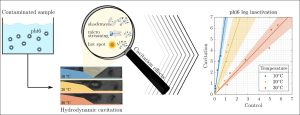In an experimental study, researchers at the Laboratory for Hydraulic Machines (LVTS) have shown that hydrodynamic cavitation can be used to successfully inactivate phi6, a virus with a lipid envelop. The results of the study were published in the renowned journal Ultrasonics Sonochemistry (IF: 9,336).

Figure 1: Graphical abstract
The COVID-19 pandemic has reminded us that better action plans are needed if we are to prevent the spread of viral infections and the emergence of epidemics or pandemics in the future. Since current methods of virus inactivation have their limitations, the only logical alternative is to explore advanced technologies that could help us effectively and efficiently control possible future outbreaks. The paper published within the CABUM project addresses this very topic, where we show that one of these alternative advanced technologies – hydrodynamic cavitation – can be successfully used to inactivate enveloped viruses. For research purposes, we have used the phi6 enveloped virus, which is often used as a surrogate virus for the investigation of lipid enveloped viruses that pose a threat to humans, such as Ebola virus, Zika virus, Dengue virus and coronaviruses.
Hydrodynamic cavitation is a physical phenomenon that describes the phase transition from liquid to gas and back to liquid at a constant temperature. It is the formation and collapse of cavitation bubbles that is responsible for the mechanical, thermal and chemical effects of cavitation, which we “exploit” for a variety of purposes. Within this study, we wanted to demonstrate that they can also be used to inactivate viruses. In two series of experiments with increasing and constant sample temperature, we achieved inactivation of phi6 up to 6.3 log. Inactivation up to 4.5 log at lower, environmentally relevant temperatures, 10 and 20 °C, occurred mainly due to the mechanical effects of cavitation. At 30 °C, the inactivation of phi6 increased up to 6 log, which was due to the effect of temperature on the viral lipid envelope, leading to a higher inactivation. This study is important as it shows that hydrodynamic cavitation has the potential to inactivate pathogenic viruses with an envelope in water under ambient conditions. Although the primary transmission of enveloped viruses does not occur via water, the recent pandemic reminds us to be prepared for the worst, as there is a possibility, however small, that waterborne enveloped viruses could emerge in the future.
Link to the article: https://doi.org/10.1016/j.ultsonch.2023.106400.